Improved Backyard Poultry
The indigenous backyard poultry breeds had low egg and meat production and face various issues as discussed above. Hence, specific improved varieties of birds are developed by several research organizations and private institutions for meat or eggs or with dual purpose to address the issues of indigenous breeds. The important features of these improved varieties are higher egg production, higher body weight gain, attractive feather colour, low input cost, high disease resistance, better survival rate and large egg size with brown colour resembling desi egg. However, desi hens can be used for brooding of eggs of improved variety birds.
Improved egg purpose varieties developed in India for rural poultry production
| Name of the Variety | Place/State where it is Developed | Characteristics/Production Parameters |
|---|---|---|
| Gramapriya | Hyderabad, Telangana | Body weight at 6 weeks and at maturity is 400-500 g and 1600-1800 g respectively. Age at first egg is 160-165 days and annual egg production (72 weeks) is 160-180. |
| CARI Nirbheek | Izatnagar, Uttar Pradesh | It is a cross of Indian native breed Aseel with CARl Red. Body weight at 20 weeks is 1847 g and 1350 g for males and females respectively. Age at sexual maturity is 176 days and annual egg production is 198. |
| CARI Shyama | Izatnagar, Uttar Pradesh | It is a cross of Kadakanath breed of Indian native chicken with CARl Red. Body weight at 20 weeks is 1460 g and 1120 g for males and females respectively. Age at sexual maturity is 170 days and annual egg production is 210. The meat is very rich in protein (25.47 %). |
| CARI HITCARI | Izatnagar, Uttar Pradesh | Developed by crossing the Indian native Naked neck with exotic breed CARI Red. Body weight at 20 weeks is 1756 g and 1320 g for males and females respectively. Age at sexual maturity is 178 days and annual egg production is 200. |
| CARI UPKARI | Izatnagar, Uttar Pradesh | Indian native chicken with Frizzle plumage has been crossed with CARI Red. It has four different varieties for different agro-climatic conditions. Body weight at 20 weeks is 1688 g and 1285 g for males and females respectively. Age at sexual maturity is 165 days and annual egg production is 220. |
| Grama Lakshmi | Mannuthy, Kerala | Age at sexual maturity is 160 days. Age at 50% egg production is 180 days. Total egg production (72 weeks) is 180-200 eggs. Body weight at 72 weeks is 1.7 kg. |
| Athulya | Kerala | Age at sexual maturity is 123 days. Age at 50% egg production is 145 days. Total egg production (72 weeks) is 280-290 eggs. Body weight at 72 weeks is 1.5 kg. |
| Kalinga Brown | Bhubaneshwar, Odisha | It is a cross of White Leghorn and Rhode Island Red birds. The body weight at day one and at 72 weeks is 27 g and 1689 g respectively. Age at sexual maturity is 122 days and age at peak production is 29-32 weeks. Annual egg production is 265-275 eggs. |
| CARI Priya Layer | Izatnagar, Uttar Pradesh | Earlier known as ILI-80, is one such commercial white egg layer. CARl Priya was developed by crossing superior male and female strains of White Leghorn. Age at first egg is 17-18 weeks and the peak egg production is found at 26-28 weeks. 50% egg production is seen at 150 days. The hen housed at 72 weeks lays more than 298 eggs. |
| CARI Sonali Layer (Golden-92) | Izatnagar, Uttar Pradesh | Developed using White Leghorn as male line and Rhode Island Red as female line. Age at first egg is 18-19 weeks and the peak egg production is found at 27-29 weeks. 50% egg production is seen at 155 days. The hen housed at 72 weeks lays more than 280 eggs. |
| Kaveri | Odisha | Good scavenging bird with body weight at 6 weeks and 20 weeks is 750 g and 2000-2200 g respectively. Attains sexual maturity at 183 days and has annual egg production is 180. |
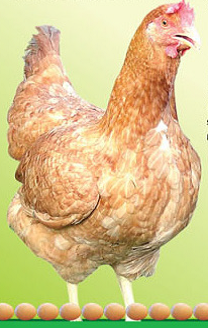
Grampriya (Source: ICAR-DPR, Hyderabad)
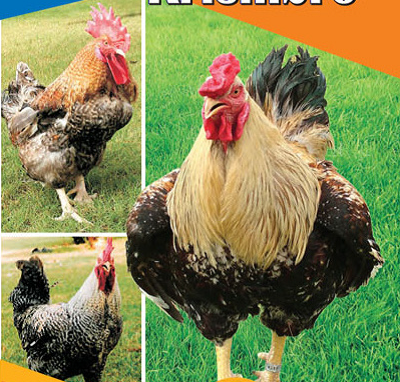
Krishibro (Source: ICAR-DPR, Hyderabad)
Few major varieties developed for egg production in India are presented in the table. The improved layer varieties have the potential of producing 140-170 eggs in a laying year in a free range conditions and 160-200 eggs at the organized farm conditions. The birds have on average 2.5-3.5 kg body weight in males and 1.5-2.0 kg body weight in females.
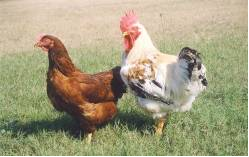 |
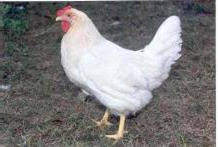 |
CARI Debendra |
CARI Sonali |
Source: ICAR-CARI, Izatnagar, Uttar Pradesh
Improved dual and meat purpose varieties for backyard poultry production
| Name of the variety | Place/state where it is developed | Purpose | Characteristics/Production Parameters |
|---|---|---|---|
| Vanaraja | Hyderabad, Telangana | Dual | Body weight at 6 weeks and at sexual maturity is 650-750 g and 2000-2200 g respectively. Age at first egg is 175-180 days and annual egg production (72 weeks) is 100-110. |
| Krishibro | Hyderabad, Telangana | Meat | It attains about 1.5 kg body weight with a feed conversion ratio of about 2.0 at 6 weeks of age. |
| CARI Debendra | Izatnagar, Uttar Pradesh | Dual | Produced by crossing coloured synthetic broiler line as male line and Rhode Island Red as female line. It is a medium-sized bird with 1100-1200 g weight and 1700-1800 g at 8th and 12th weeks respectively. The age at sexual maturity is 155-160 days and annual egg production is 190-200 eggs. The feed conversion ratio is about 2.5-2.6 up to 8 weeks of age. |
| Giriraja | Bengaluru, Karnataka | Dual | Age at egg laying is 175 days. The hens lay about 140-150 eggs annually. Avg. standard body weight is 3-3.5 kg in males and 2-2.5 kg in females. Period required to attain 1.6 kg body weight is 8 weeks. |
| Swarnadhara | Bengaluru, Karnataka | Dual | Weight of day-old chick 45-50 g; Avg. standard body weight is 3-3.5 kg in males and 2-2.5 kg in females. Period required to attain 1 kg body weight is 8 weeks. Age at egg laying is 156 days. The annual egg production is 180-200 eggs. |
| Nandanam I | Chennai, Tamil Nadu | Dual | Red plumage, brown-shelled eggs, and high fertility are salient features. Hen has egg production of 180 eggs per annum; and it attains one Kg body weight at 12 weeks of age. |
| Nandanam II | Chennai, Tamil Nadu | Meat | Bodyweight of 1.44 kg at 8th week with feed efficiency of 2.66. Most popular among semi-urban farmers as a backyard bird due to attractive plumage. |
| Jharsim | Ranchi, Jharkhand | Dual | The weight at 6 weeks is 400-500 g and weight at sexual maturity is 1600-1800 g. The age at first egg laying is 175-180 days and the birds have the potential to lay 165-170 annually in the backyard system. |
| Kamrupa | Guwahati, Assam | Dual | Three-way cross using Assam local type (25%), colored broiler (25%), and Dalhem Red (50%). Bodyweight at 8 and 20 weeks is 500-650 g and 1300-1500g respectively. Male weighs 1800-2200 g at 40 weeks of age. Annual egg production is 118-130 eggs. |
| Pratapdhan | Udaipur, Rajasthan | Dual | The weight of day-old chick is 35 g while Weight at 20 weeks is 2309 g in males and 1734 g in females. The age at sexual maturity is 170 days and annual egg production is 161 eggs. The average age at first egg production is 125 days. |
| CARIBRO-Vishal (CARIBRO-91) | Izatnagar, Uttar Pradesh | Meat | The weight of day-old chick is 43 g while the weight at 6th and 7th weeks is 1650-1700 g and 2000-2150 g respectively. The feed conversion ratio at 6 weeks is 1.85. |
| CARI BRO TROPICANA | Izatnagar, Uttar Pradesh | Meat | This is suitable for hot & humid regions. The bodyweight at 6th and 7th weeks is 1300g and 1800 g respectively. The feed conversion ratio at 7 weeks is 2.11. |
| CARIBRO-Dhanaraj | Izatnagar, Uttar Pradesh | Meat | CARIBRO Dhanraja is the most preferred bird among farmers because of its multi-colored plumage and high economic returns. The weight of day-old chick is 46 g while the weight at 6th and 7th weeks is 1500-1700 g and 2000-2125 g respectively. The feed conversion ratio at 7 weeks is 1.92. |
| CARIBRO Mrityunjay | Izatnagar, Uttar Pradesh | Meat | CARIBRO Mrityunjay is a commercial cross suitable for hot and dry regions. The weight of day-old chick is 38-42 g while the weight at 6th and 7th weeks is 1400-1500 g and 1800-2000 g respectively. The feed conversion ratio at 6 and 7 weeks is 1.95 and 2.11 respectively. |
| Srinidhi | Hyderabad, Telangana | Dual | Body weight at 6 weeks and 20 weeks is 600-650 g and 1700-2000 g respectively. Age at first egg is 165-170 days. The annual egg production is 140-150 eggs under backyard. |
| Narmadanidhi | Jabalpur, Madhya Pradesh | Dual | It is having 25% inheritance of native i.e. local breed Kadaknath and 75% of improved broiler germplasm (Jabalpur col.). Male attains 1 kg body weight in 9-10 weeks of age and body weight at 20 weeks ranged from 1550 to 2210g in males and 1310 to 1730g in females. The female mature at about 161 days of age and produces 181 eggs in the backyard system of management. |
| Himsamridhi | Palampur, Himachal Pradesh | Dual | Day old body weight is 35-39 g and body weight at 8 weeks is 400-600 g. Body weight at 20 weeks is 1400-1700 g and 1250-1400 g for males and females respectively. Age at first egg is 170-190 days and the total egg production is 140-170 eggs annually. |
| Chabro | Hesaraghatta, Karnataka | Meat | Bird with Multi colored Plumage, which attains 1.6 – 1.7 kg body weight in 60 days. Day old body weight is 40 g and has a feed conversion ratio of 2.48. It is fit for backyard farming. |
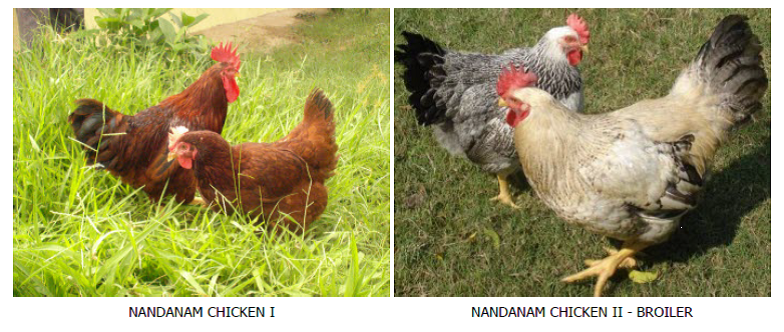 |
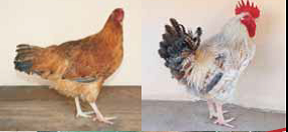
Pratapdhan poultry (Source: MPUAT, Udaipur)
Few examples of dual/meat purpose varieties developed in India are
presented in table. These varieties developed for meat purpose have the
potential to gain 1.4 to 1.6 kg body weight in 8 weeks of age in semi
intensive conditions but the dual purpose varieties may gain only 1.2
-1.4 kg body weight during the same period.
The body weight of dual
or meat purpose birds depends on the quality and quantity of feed and
management practices followed by the farmer.
Recently, Raja II broiler breed has been developed by Department of
Poultry Science, Veterinary College, Bangalore, (KVAFSU) with a funding
by ICAR, which has similar plumage pattern similar to backyard rural and
gains weight 1.6-1.8 kg by consuming 3.5 kg of feed in 6 weeks.
Problems with improved varieties developed for meat and dual-purpose
stock are their non-flying capacity due to heavy body weights, so prone
to predation. They also require more feed supplement to fulfill their
nutritional requirements.
Management of improved verities of Backyard Poultry
Backyard poultry can be reared for egg production in small numbers (10-20) in free range conditions if optimum natural feed resources are available. However, if the local demand is for meat, they can be reared in large number under intensive/ semi-intensive conditions by providing all inputs similar to commercial broilers. However, these birds need to be reared under proper brooding/nursery management upto 6 weeks and later, they may be released in free range or scavenging system after 6 weeks of age.

